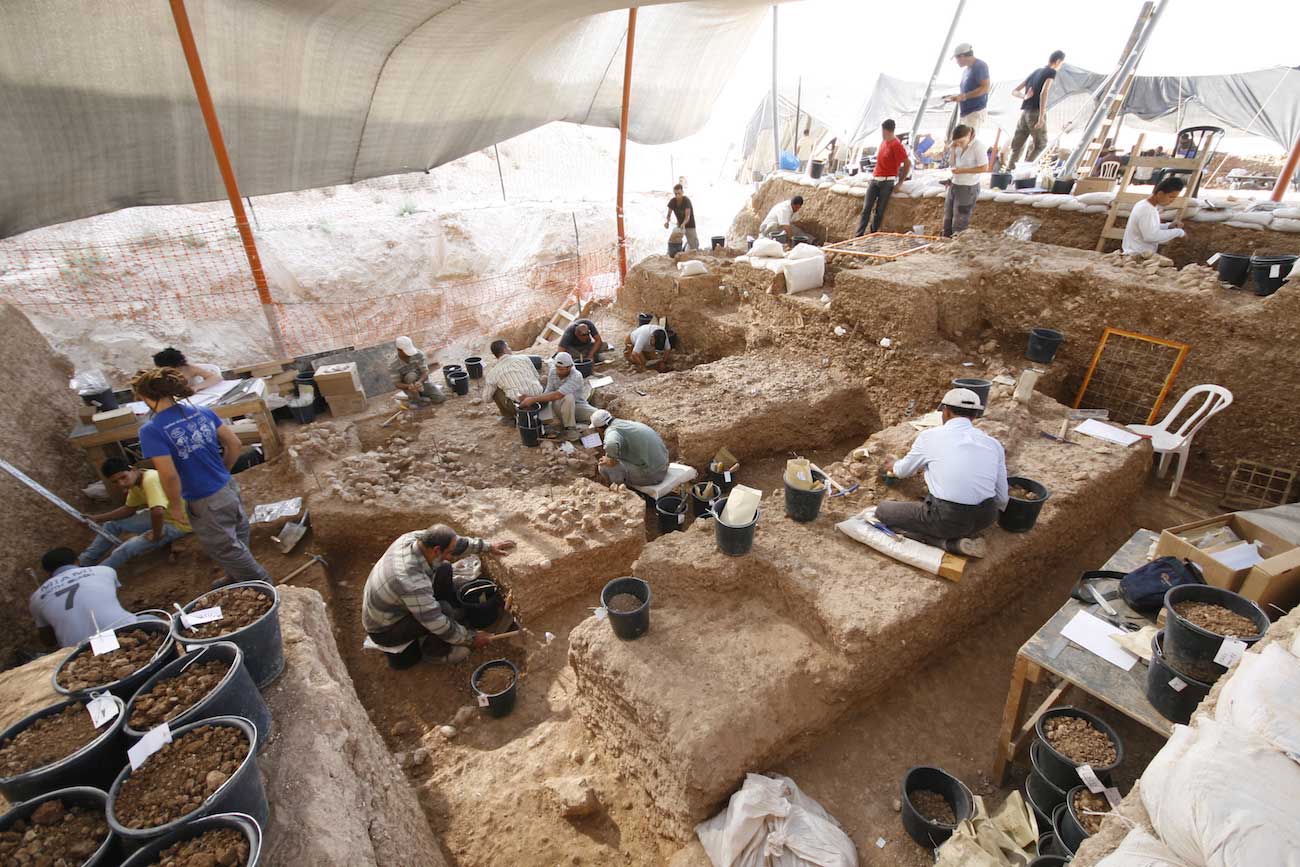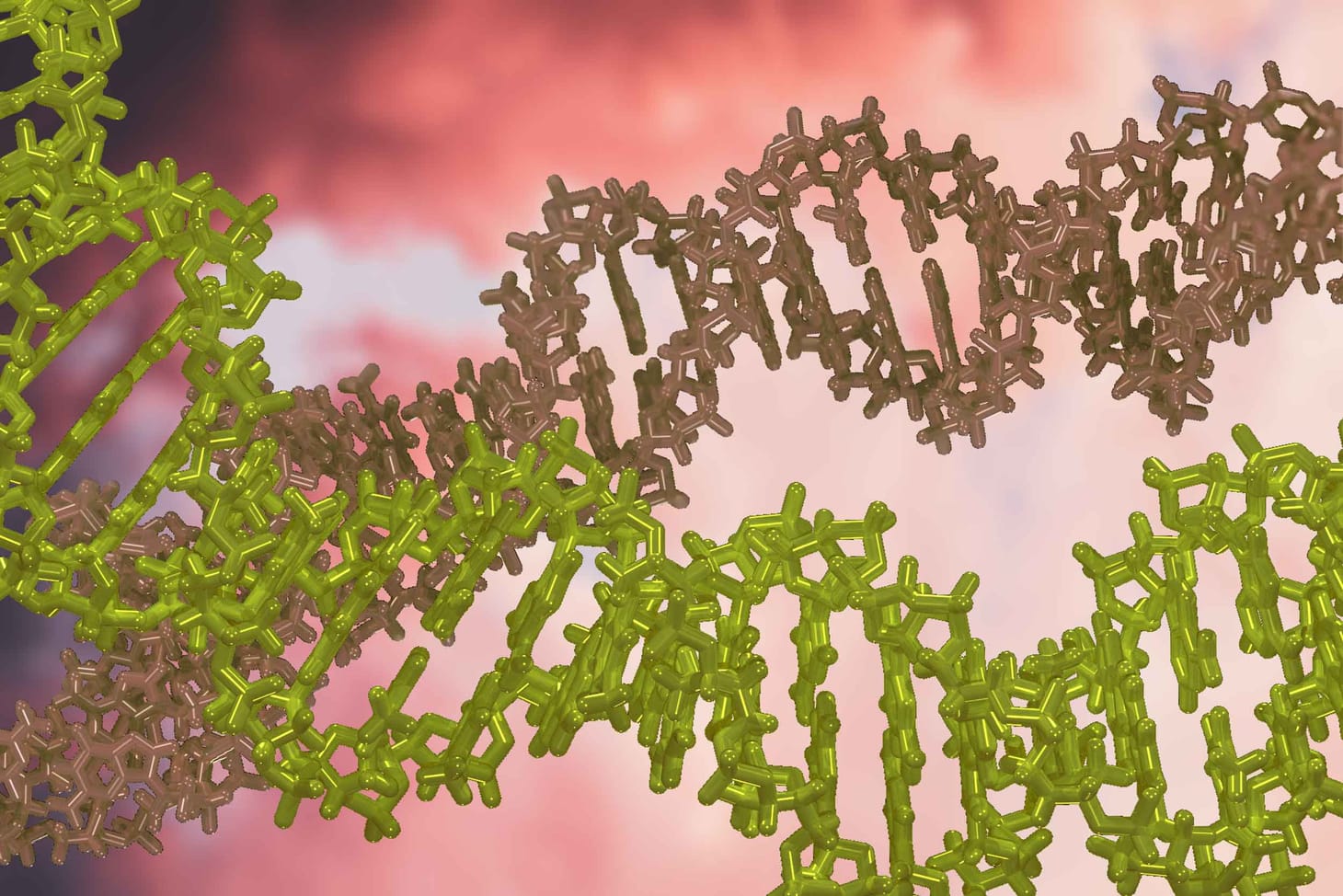The Nesher Ramla site: a third way between Neandertals and modern humans?
Fragments representing people who lived just before Skhūl and Qafzeh seem outside the expectations for these “early modern humans” or for Neandertals.

Nesher Ramla is an archaeological site midway between the modern cities of Tel Aviv and Jerusalem, which was discovered inside of a working quarry. The archaeological site formed as ancient people used a sinkhole for shelter in an open landscape, gradually filling it with their stone artifacts, the bones of animals they hunted, and their ancient fires. Archaeologists have been working in the site and publishing their findings for a decade.
Last year, the site made headlines because of two pieces of human bone from sometime between 140,000 and 120,000 years ago. These pieces come from an archaeological layer with tools of similar manufacture to those from the slightly later sites of Qafzeh and Skhūl. Both these later sites have skeletal remains that anthropologists have often classified as “modern humans”. The Nesher Ramla hominin fossils are different, and the scientists who described them suggest that they may be a third form of human, separate from both Neandertals and modern people.
I wouldn't go quite so far on the evidence they have found. But these fossils and artifacts are at a critical time and place in human origins. They may give clues about the mixture of African and Eurasian populations at the last time that climate approached the warm phase of the last 10,000 years.
Ancient mixing
The ancestors of Neandertals and African ancestors of today's humans share a complicated history of interactions. The two lineages come from common ancestors that lived before 700,000 years ago. One of these lineages was an African branch that would give rise to more than 92% of the genetic variation of all humans on the planet today. The other lineage led to Neandertals and Denisovans, both ancestors of today's people but a much smaller fraction of our genetic heritage.
During the evolution of these lineages, they mixed with each other repeatedly. Some episodes of mixture were ephemeral without giving rise to long-distance introgression. For example, the repeated mixing of Neandertals and Denisovans in central Asia is abundantly documented from ancient DNA evidence, but geneticists have not yet identified many introgressed Denisovan genes in European Neandertals.
Mixing between Neandertals and African populations had more lasting impacts. We have gene sequences from Neandertals as early as Sima de los Huesos, some 430,000 years ago, up to the end of their existence around 40,000 years ago. All Neandertal genomes after 250,000 years ago had entirely lost their original Y chromosome and mtDNA lineages, and had new ones introduced into their populations from African sources. By some estimates these later Neandertal genomes had as much as 10% content from African source populations. Today's people inside Africa have little evidence of Neandertal introgression from before 100,000 years ago, and so the history of genetic exchanges appears to have been asymmetrical.
The fossil record gives some hints about these ancient interactions. During the 1930s, Dorothy Garrod directed excavations in several cave sites in Israel, including Tabun and Skhūl. Both sites yielded fossil skeletons of ancient humans, now considered to date to between 120,000 and 90,000 years ago. When Theodore McCown and Arthur Keith described these remains, they emphasized the mixture of Neandertal-like and modern characteristics across the sample. The evolutionary biologist Theodosius Dobzhansky concluded that they reflected hybridization between the ancient groups. Further discoveries from the region, including the burials from Qafzeh Cave, tend to reinforce the idea that the Levant received streams of people from varied ancestries in this period of time.
Over the past ten years this story of mixture has stretched into a deeper timeframe. Two sites dating to before 160,000 years ago have human fossils that researchers describe as similar to modern people and not Neandertals. Neither is a very rich source of anatomical information: a partial maxilla from Misliya Cave, Israel, and the posterior part of a cranial vault from Apidima, Greece. But both suggest that Neandertals were being infiltrated by other people who were very different from them—people whose cranial form resembled “modern” humans from much later in time.
Nesher Ramla
The site gets its name from the Nesher cement factory and the nearby town of Ramla. After the discovery of the site, archaeologists carried out a salvage excavation in 2010 and 2011 to investigate it. They found 8 meters of sediment accumulation, with the lowest excavated layer, unit VI, going back to an estimated 140,000 to 120,000 years ago. The team estimated this range of ages from combined U-series ESR dating on faunal teeth and thermoluminescence dating on burned flint. Unit V, which directly overlies the unit VI layer with the hominins, has nearly the same range of TL and US-ESR dates, suggesting that much of this sequence accumulated over the same time interval.
The hominin fossils are a partial mandible (NR-2) and a right parietal bone with parts of the left parietal (NR-1); the two may represent a single individual but they may come from different individuals, the evidence doesn't make it possible to know. The research paper describing these fossils, by Israel Hershkovitz and coworkers, made the very strong claim that they represent “a previously unrecognized group of hominins”.

The NR-2 mandible is similar in several ways to early Neandertal skeletal remains, such as those from Krapina, Croatia, or the much earlier site of Sima de los Huesos, Spain. Hershkovitz and coworkers recognized these Neandertal similarities, and suggested that the jaw “belongs to an archaic group with Neanderthal affinities”. That seems right to me, although I'm not sure whether there's a difference between “Neandertal affinities” and “Neandertal”.
While the mandible looks like early Neandertals, the NR-1 parietal bone is a little different in shape than most Neandertals. Neandertal cranial vaults tend to have long parietal bones that are evenly rounded in their cross-section. These contribute to the so-called barrel shape of the Neandertal cranial vault, which has its maximum width acros the lower part of the parietal bones. Today's people share a much higher, more rounded cranial vault that is shorter from front-to-back and has its maximum width high on the parietals.
Neandertals and recent people both have vaults that were shaped differently from their common ancestors. The pattern of most early members of Homo had the maximum width of the skull near its base, often with an angle along the parietal where the temporalis muscles originate. This ancestral pattern is shared by Homo erectus and many “Middle Pleistocene Homo” skulls like those from Kabwe, Zambia, or Petralona, Greece. Hershkovitz and coworkers show that the shape of the Nesher Ramla parietal is near the area of overlap between these archaic humans, Homo erectus, and Neandertals. The Nesher Ramla parietal is at the small end of Neandertals, and this small size may contribute to its shape.
A third group?
The researchers who described these fossils concluded that they could not assign them to Neandertals. They favored the idea that these fossils, grouped together with earlier fossils like those from earlier sites in the Levant, like Qesem Cave and Zuttiyeh, might represent a distinct population—different both from Neandertals and from African ancestors of today's humans. They wrote:
“We suggest addressing this Levantine MP paleodeme as the ‘Nesher Ramla Homo’. Its presence from ~420 to 120 ka ago in a geographically restricted area may have allowed for repeated interbreeding with modern human populations such as the people from Misliya Cave.”—Israel Hershkovitz and coworkers
It is a provocative suggestion that a long-lasting separate population once existed in southwest Asia. The idea puts together at least three fossil samples in the region that otherwise don't fit together with Neandertals nor contemporary fossil samples in Africa. I compare it to the work on European Middle Pleistocene fossils by Mirjana Roksandic and her collaborators, who have observed that some don't fit as early Neandertals or ancestors of Neandertals. Were there possibly third—or fourth—or even more populations out there?
One possibility may fit well, and I've not seen anybody mention it. We already know that there was a third population out there: the Denisovans. The DNA data from central Asia show us that Neandertal and Denisovan populations were sometimes in contact with each other, across more than 100,000 years of time, and that they mixed where they met. We do not know what the geographic range of Denisovans may have been across the southern tier of Asia. Many researchers have emphasized the Denisovans as an “eastern” population, due to the high representation of Denisovan ancestry in island southeast Asia and Oceania. But we have very little fossil evidence about the ancient populations of India and Pakistan, and the known Neandertals from Teshik-Tash, Uzbekistan and Shanidar, Iraq, are more recent than 100,000 years. So why not Denisovans in the Levant before 120,000 years ago?
Still, it gives me pause that the fossil data just aren't good enough to rule out such a scenario. We know more about Neandertals than any other population from this time period, and that's still not enough to fully characterize Neandertal variation. Across 400,000 years of evolution, not every member of a “Neandertal” population is going to have the traits that anthropologists first recognized and defined in fossils of the last 120,000 years. Their groups varied across space and time, and we do not begin to have enough fossils to accurately describe that variation.
The Nesher Ramla fossils fall within or just outside the known range of variation of Neandertals and early Neandertals. They are interesting and worth considering how they relate to the population movements that must have been happening across this region. Connections between the Nesher Ramla and Krapina populations would be especially interesting to investigate. I'm just glad they didn't name a species.
References
Hershkovitz, I., May, H., Sarig, R., Pokhojaev, A., Grimaud-Hervé, D., Bruner, E., Fornai, C., Quam, R., Arsuaga, J. L., Krenn, V. A., Martinón-Torres, M., de Castro, J. M. B., Martín-Francés, L., Slon, V., Albessard-Ball, L., Vialet, A., Schüler, T., Manzi, G., Profico, A., … Zaidner, Y. (2021). A Middle Pleistocene Homo from Nesher Ramla, Israel. Science, 372(6549), 1424–1428. https://doi.org/10.1126/science.abh3169
Lahr, M. M. (2021). The complex landscape of recent human evolution. Science, 372(6549), 1395–1396. https://doi.org/10.1126/science.abj3077
Paixão, E., Marreiros, J., Dubreuil, L., Gneisinger, W., Carver, G., Prévost, M., & Zaidner, Y. (2022). The Middle Paleolithic ground stones tools of Nesher Ramla unit V (Southern Levant): A multi-scale use-wear approach for assessing the assemblage functional variability. Quaternary International, 624, 94–106. https://doi.org/10.1016/j.quaint.2021.06.009
Prévost, M., Groman-Yaroslavski, I., Crater Gershtein, K. M., Tejero, J.-M., & Zaidner, Y. (2022). Early evidence for symbolic behavior in the Levantine Middle Paleolithic: A 120 ka old engraved aurochs bone shaft from the open-air site of Nesher Ramla, Israel. Quaternary International, 624, 80–93. https://doi.org/10.1016/j.quaint.2021.01.002
Zaidner, Y., Centi, L., Prévost, M., Mercier, N., Falguères, C., Guérin, G., Valladas, H., Richard, M., Galy, A., Pécheyran, C., Tombret, O., Pons-Branchu, E., Porat, N., Shahack-Gross, R., Friesem, D. E., Yeshurun, R., Turgeman-Yaffe, Z., Frumkin, A., Herzlinger, G., … Hershkovitz, I. (2021). Middle Pleistocene Homo behavior and culture at 140,000 to 120,000 years ago and interactions with Homo sapiens. Science, 372(6549), 1429–1433. https://doi.org/10.1126/science.abh3020
Zaidner, Y., Frumkin, A., Porat, N., Tsatskin, A., Yeshurun, R., & Weissbrod, L. (2014). A series of Mousterian occupations in a new type of site: The Nesher Ramla karst depression, Israel. Journal of Human Evolution, 66, 1–17. https://doi.org/10.1016/j.jhevol.2013.06.005
John Hawks Newsletter
Join the newsletter to receive the latest updates in your inbox.



